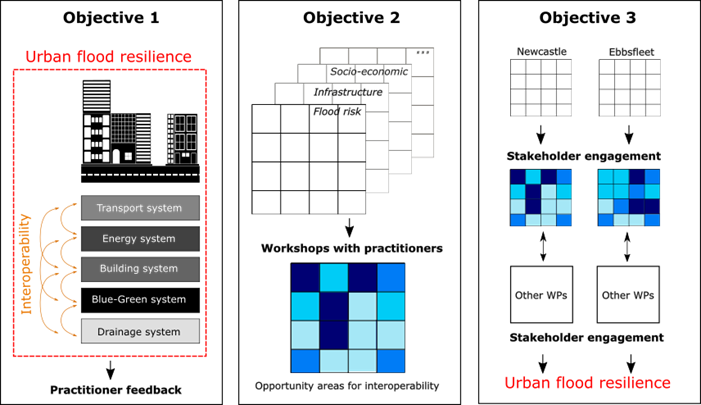WP3. Interoperability with other systems
We investigated the potential for employing interoperable Blue-Green and Grey infrastructure to increase urban flood resilience. Specifically, WP3 aimed to produce the knowledge and approach necessary to facilitate a system-of-systems approach to urban flood management through the concept of interoperability.
Interoperability: the active management of connections between urban systems to increase the functionality of the whole system (the city) to deal with water exceedance events.

Photo 1 (left) Creative example of interoperability: Parisians keeping their feet dry using a bridge of chairs after a flood of the Seine in 1924. (Source: Astonishing Pictures Twitter Account: @AstonishingPix, 1 Feb 2016).
Photo 2 (right) Existing example of interoperability: a speed hump and earth bund redirect water away from residential houses towards the highway for temporary storage in Dudley Metropolitan Borough Council, UK (Source: Digman, C. et al., (2014) Managing urban flooding from heavy rainfall - encouraging the uptake of designing for exceedance, CIRIA).
WP3 Objectives
Objective 1
- Conceptualise interoperability in the context of urban flood management and investigate the potential for enhancing the connection of Blue-Green/Grey water management infrastructure with existing assets and systems (drainage and transport networks, green space, etc.) to increase drainage capacity and reduce flood risk. A factsheet and concept paper will serve as a starting point for discussion and engagement with practitioners about a system-of-systems approach to flood management.
Objective 2
- Investigate how to use spatial information (e.g. on flood risk, infrastructure, socio-economic characteristics, etc.) to screen urban areas to locate opportunity areas for connecting existing infrastructure systems and identifying possibilities for interoperability. To this end, primary and secondary data will be drawn from ordinance survey sources and engagement with flood management practitioners, infrastructure asset owners and service operators to identify infrastructure interdependencies and vulnerabilities.
Objective 3
- Use the developed interoperability screening approach to demonstrate and evaluate interoperable solutions alongside other work package outputs at case study localities and by extension wider urban environments nationally (WP5).

WP team